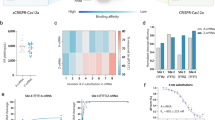Abstract
CRISPR/Cas9 is the genome-editing technology that is most widely used around the world. Its widespread adoption is largely due to its simplicity and ease of use. Here, we introduce the construction of vectors and genome editing of the target gene in cells using the CRISPR/Cas9 system.
Access this chapter
Tax calculation will be finalised at checkout
Purchases are for personal use only
Similar content being viewed by others
References
Jinek M, Chylinski K, Fonfara I, Hauer M, Doudna JA, Charpentier E (2012) A programmable dual-RNA-guided DNA endonuclease in adaptive bacterial immunity. Science 337:816–821
Kim YG, Cha J, Chandrasegaran S (1996) Hybrid restriction enzymes: zinc finger fusions to Fok I cleavage domain. Proc Natl Acad Sci U S A 93:1156–1160
Miller JC, Tan S, Qiao G, Barlow KA, Wang J, Xia DF et al (2011) A TALE nuclease architecture for efficient genome editing. Nat Biotechnol 29:143–148
Naito Y, Hino K, Bono H, Ui-Tei K (2015) CRISPRdirect: software for designing CRISPR/Cas guide RNA with reduced off-target sites. Bioinformatics 31:1120–1123
Guschin DY, Waite AJ, Katibah GE, Miller JC, Holmes MC, Rebar EJ (2010) A rapid and general assay for monitoring endogenous gene modification. Methods Mol Biol 649:247–256
Acknowledgments
This work was supported by grants from the Basic Science and Platform Technology Program for Innovative Biological Medicine from the Ministry of Education, Culture, Sports, Science, and Technology, Japan (MEXT); the Research Support Project for Life Science and Drug Discovery (Basis for Supporting Innovative Drug Discovery and Life Science Research (BINDS)) from Agency for Medical Research and Development (AMED) under Grant Number JP22ama121049; and the Practical Research Project for Rare/Intractable Diseases from AMED.
Author information
Authors and Affiliations
Corresponding author
Editor information
Editors and Affiliations
Rights and permissions
Copyright information
© 2023 The Author(s), under exclusive license to Springer Science+Business Media, LLC, part of Springer Nature
About this protocol
Cite this protocol
Hatada, I., Morita, S., Horii, T. (2023). CRISPR/Cas9. In: Hatada, I. (eds) Genome Editing in Animals. Methods in Molecular Biology, vol 2637. Humana, New York, NY. https://doi.org/10.1007/978-1-0716-3016-7_3
Download citation
DOI: https://doi.org/10.1007/978-1-0716-3016-7_3
Published:
Publisher Name: Humana, New York, NY
Print ISBN: 978-1-0716-3015-0
Online ISBN: 978-1-0716-3016-7
eBook Packages: Springer Protocols




